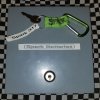One more question. Everything I read online says the charger current should not exceed "C" which is
battery MAh / 1000. The
spark batteries are 1480 MAh so by that rule the charger should not exceed 1.5 A. The charger that shipped with the Spark is rated at 5V/3A; 9V/2A; 12V/1.5A. The voltage of the
battery says 11.4V. So based on that, this is the most powerful charger I should be using. Am I interpreting this correctly?
Sorry for all the **** questions,
There's no such thing as a silly question except the one you should have asked but didn't.
LiPo
batteries have a huge advantage in how quickly they can discharge ... 4 or 5 C is possible but the chemistry required to make this possible makes them volatile and particularly vulnerable to poor charging or penetrating damage. They *can* also if handled correctly charge at better than 1C but that shortens
battery life, requires some know how to do safely and is out of the scope of this discussion so we'll leave it.
Most LiPo used in R/C applications are "dumb"
batteries. They are a group of cells in series and or parallel and that's it. Charging them safely is up to you and your charger. I'm a Technician by trade and been doing the R/C thing for going on 30 years so I'm fairly across it by now. The average dumb flight
battery needs two connections to the charger, one to the actual charge input and one to the inbuilt cell balance circuitry of the charger. My flight charger retails at about $600 and I didn't begrudge a cent of it. You only have to see one LiPo fire to be convinced.
We on the other hand have it easy with our R.P.A.s, DJI have been kind to us and most (if not all?) of their
batteries are "smart"
batteries and carry integrated smart charge/dischage controllers onboard which also offer short and over draw protection as well as auto discharge. Initially I was skeptical of just how good these systems were. Over time I have become convinced. Nothing is fool proof however, "idiocy resistant" is the best you can hope for.
Generally speaking anyway (not always but mostly) a device will only draw the current it requires. If it needs 1 amp and you connect it to a 500amp supply, no problem as long as the voltage is right. Connect it to something with too high a voltage and then it's fireworks time!
Short answer, always use your DJI charger or an aftermarket charger manufactured by a reputed company and designed for the
battery you are using when you possibly can. If you are caught out and have no choice ... for example you have the charging dock but the power brick has died .. then use one not exceeding the maximum rated voltage of the original and don't worry about current output as long as it is not way lower than required as then overheating of the charger will be an issue.
Never leave your
batteries unattended while charging whether using the original charger or not.
I have the DJI Docks for all my aircraft and have made cables to connect them to my flight charger. It has four charging "channels" so I programme each channel to output the expected input of the dock connected to it and charge Spark, Mavic, Phantom etc
batteries at the same time if under time constraints (I own an R.P.A. business) but if time is not a factor I still use the original DJI equipment every time.
Regards
Ari




